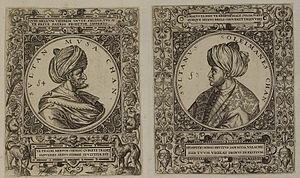Ottoman Interregnum
Civil war in the early 15th century Ottoman Empire From Wikipedia, the free encyclopedia
The Ottoman Interregnum, or Ottoman Civil War,[8] (Turkish: Fetret devri,[9] lit. 'Interregnum period') was a civil war in the Ottoman Empire between the sons of Sultan Bayezid I following their father's defeat and capture by Timur in the Battle of Ankara on 20 July 1402. Although Timur confirmed Mehmed Çelebi as sultan, Mehmed's brothers (İsa Çelebi, Musa Çelebi, Süleyman Çelebi, and later Mustafa Çelebi) refused to recognize his authority, each claiming the throne for himself,[10] which resulted in civil war. The Interregnum would last a little under 11 years and culminate in the Battle of Çamurlu on 5 July 1413, when Mehmed Çelebi emerged as victor, crowned himself Sultan Mehmed I, and restored the empire.
| Ottoman Interregnum | |||||||||
|---|---|---|---|---|---|---|---|---|---|
 Late 16th-century depiction of Musa and Süleyman, facing each other | |||||||||
| |||||||||
| Belligerents | |||||||||
|
Mehmed's forces Serbian Despotate | İsa's forces | Süleyman's forces |
Musa's forces Wallachia | ||||||
| Commanders and leaders | |||||||||
|
Mehmed Çelebi Stefan Lazarević Imamzade Halil Pasha |
İsa Çelebi Junayd of Aydın[a][1][2] |
Süleyman Çelebi † Orhan Çelebi[c] |
Musa Çelebi Mircea the Elder[6] Sheikh Bedreddin[7] | ||||||
Civil war
Summarize
Perspective
İsa and Mehmed
Civil war broke out among the sons of Sultan Bayezid I upon his death in 1403. His oldest son, Süleyman, with his capital at Edirne, ruled the recently-conquered Second Bulgarian Empire, all of Thrace, Macedonia, and northern Greece. The second son, İsa Çelebi, established himself as an independent ruler at Bursa,[11] and Mehmed formed a kingdom at Amasya.[12] War broke out between Mehmed and İsa, and following the Battles of Ermeni-beli[13] and of Ulubad (March–May 1403),[11] İsa fled to Constantinople, and Mehmed occupied Bursa.[14] The subsequent battle at Karasi between Mehmed and İsa resulted in Mehmed's victory and Isa fleeing to Karaman.[13] İsa was later killed in a bath by agents of Mehmed.[15]
Süleyman enters civil war
Meanwhile, the other surviving son of Bayezid, Musa Çelebi, who was captured at the Battle of Ankara, was released by Timur into the custody of Yakub of Germiyan.[16] Musa was freed after Mehmed made a request for his brother's release. Following İsa's death, Süleyman crossed the straits with a large army.[17] Initially, Süleyman was successful. He invaded Anatolia, capturing Bursa (March 1404)[18] and Ankara later that year.
During the stalemate in Anatolia, which lasted from 1405 to 1410, Mehmed sent Musa across the Black Sea to Thrace with a small force to attack Süleyman's territories in south-eastern Europe. The maneuver soon recalled Süleyman to Thrace, where a short but sanguinary contest between him and Musa ensued. At first, Süleyman had the advantage and won the Battle of Kosmidion in 1410, but in 1411 his army defected to Musa at Edirne. Süleyman was captured, given to Musa's bodyguard, Koyun Musasi, and strangled to death on 17 February 1411.[19][20] Musa was now the ruler of the Ottoman dominions in Thrace.
Mehmed and Musa
Manuel II Palaiologos, the Byzantine emperor, had allied with Süleyman. Mûsa, therefore, besieged Constantinople.[21] Manuel called on Mehmed to protect him, and Mehmed's Ottomans now garrisoned Constantinople against Musa's Ottomans of Thrace. Mehmed made several unsuccessful sallies against his brother's troops and was obliged to recross the Bosporus to quell a revolt that had broken out in his own territories. Musa now pressed the siege of Constantinople. Mehmed returned to Thrace, and obtained the assistance of Stefan Lazarevic, the Serbian Despot.
The armies of the rival Ottoman brothers met on the Plain of Chamurli (now Samokov, Bulgaria). Hassan, the Agha of the Janissaries of Mehmed, stepped out before the ranks and tried to get the troops to change sides. Musa rushed towards Hassan and killed him, but was himself wounded by an officer who had accompanied Hassan. Musa's Ottomans fought well, but the battle was won by Mehmed and his allies.[22] Musa fled but was later captured and strangled.[23] With Musa dead, Mehmed was the sole surviving son of the late Sultan Bayezid I and became Sultan Mehmed I.
The Interregnum was a striking example of the fratricide that would become common in Ottoman successions.
Political titles
During the Interregnum, only Mehmed minted coins titling himself Sultan. His brother Süleyman had coins that call him Emir Suleyman b. Bayezid, and Musa's coins state, Musa b. Bayezid. No coins of İsa have survived.[24]
- Coin of Mehmed, citing Timur as overlord
- Coin of Süleyman
- Coin of Musa
Notes
- After the death of Suleyman Çelebi, Orhan, his very young son attempted to take over the kingdom with the help of certain lords, but his paternal uncle Musa attacked him and, through betrayal rather than battle, ...[5]
References
Bibliography
Wikiwand - on
Seamless Wikipedia browsing. On steroids.



